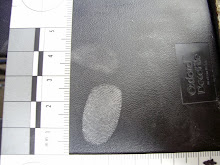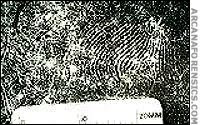 Have you ever wanted to be like Inspector Clueso or like a CSI person or wondered how the things they did worked? One of the most important "clues" in forensics is fingerprinting. There are many different ways to develop fingerprints, some may seem obvious or others may be impressive or mysterious looking. For example, have you ever been watching CSI or NCIS and they produce a gaseous fume and some how it makes the fingerprints vi sable? This may seem like magic or you may say "that's just a TV thing." Well I have news for you...its not! Have you ever heard of something called cyanoacrylate? no? How about superglue? Superglue's particles , when heated, tend to stick on the oils leftover from the ridges on your fingerprint. And when it dries, it stays. We also have access to chemicals like Vacuum Metal Deposition or VMD. This is usually used on items like a plastic bag but can be used on objects that have been submerged in water! You would that water would wash away the print but when the VMD dissolves a layer of gold followed by Zinc the print becomes visable. Although today recycled bags are more common, so for those they made a VMD that dissolves the silver once again leaving the print.
Have you ever wanted to be like Inspector Clueso or like a CSI person or wondered how the things they did worked? One of the most important "clues" in forensics is fingerprinting. There are many different ways to develop fingerprints, some may seem obvious or others may be impressive or mysterious looking. For example, have you ever been watching CSI or NCIS and they produce a gaseous fume and some how it makes the fingerprints vi sable? This may seem like magic or you may say "that's just a TV thing." Well I have news for you...its not! Have you ever heard of something called cyanoacrylate? no? How about superglue? Superglue's particles , when heated, tend to stick on the oils leftover from the ridges on your fingerprint. And when it dries, it stays. We also have access to chemicals like Vacuum Metal Deposition or VMD. This is usually used on items like a plastic bag but can be used on objects that have been submerged in water! You would that water would wash away the print but when the VMD dissolves a layer of gold followed by Zinc the print becomes visable. Although today recycled bags are more common, so for those they made a VMD that dissolves the silver once again leaving the print.People wonder: How did we discover this stuff? Well it all started in 1823 with a man named Purkinje who classified fingerprints as 9 types.

Then 20 years later in 1870 Dr. Henry Faulds realized the importance of fingerprints as a means of identification and devised a means of lifting them via ink. Then in 1892 a policeman named Juan Vucetich booked Francis Rojas, a woman who murdered her 2 sons, and her file included Rojas' fingerprints. Then everything shot up exponentially and today in 2009, America holds about 100,000,000 fingerprints of criminals in the largest AFIS building in the US.
Today there are many ways of developing and collecting fingerprints. Another modern technique for developing fingerprints is using a chemical called Silver Nitrate. This can be found in black and white photographic film. When the chlorine in the oils of your hand mix with the silver nitrate and it creates silver chloride. This makes it visible in a UV light and makes a reddish brown color. This can be followed by collecting the fingerprint by taking a picture of it. Another rather "old fashioned" method is to use ninhydrin. This surprisingly takes a very long time to react with the oils in your hand and can take hours. If you heat it, it wont take as long and the print only lasts a few minutes. So if you spray on a mixture of water and starch it will stay for weeks maybe months. You can collect the fingerprint if the object is small enough to take back to the lab. There is also the classic powder and brush to develop it and then lift the fingerprint with tape. The last method of collecting a fingerprint is using Iodine. When it is heated it releases fumes that react with the oils left over from the fingerprint and makes it visible with a brownish color. You can also lift fingerprints by pressing it into a soap, wax or putty.
There are 3 different types of fingerprints: Latent, plastic, and direct. Latent fingerprints are left from the oils on the ridges of your finger. It is invisible to the naked eye, therefore it has to be developed. The second is plastic like if you touch something plastic it will leave a negative impression of your fingerprint. This happens in things like a bar of chocolate, candles, newly painted objects, fresh cement or in the sticky stuff on envelops or stamps. Direct is a visible fingerprint that is made visible by things like flour, soot, dust ink ect.






Putting the picture of Pink Panther, drew me in. Not starting with just facts makes me want to keep reading. This post is really good.
ReplyDeleteHamp way to go you suprisingly amazed me with your massive research that you acquired and let me tell you its not easy to wow me and you did for today. I enjoyed reading your blog it would have been very informative if i didn't already know the material
ReplyDeleteI really enjoyed the style of writing you used! It was very engaging (as well as informative) and made me want to read more. Its easy to tell you did a lot of reasearch and understood the material. I also liked the pictures and balance of scientific facts and historical facts.
ReplyDeleteThis is really good. The information is at a good amount, and the relating pictures fit well. Great job!
ReplyDeleteWow you acquired alot of good information . you actualy gave and explaned each way of getting visible fingerprints
ReplyDeleteYour introduction was amazing! It surprised me how you related a serious topic like forensics to a cartoon figure. Most of Us will probably not have such a comparison. Anyways your different pictures are informative as well as attractive. Keep up the good work.
ReplyDeleteHey! I really liked your blog (as mentioned before) and I was wondering what you thought about the possibility of damaging evidence through forensic science? I know that occiasionaly scientists only have a samll sample and may have to ruin or damage it during tests. How can we weigh the pros and cons? And how should we document public crimes scenes that can only stay sectioned of for a short period of time?
ReplyDeletethats a good question. I once viewed a Law&Orden episode were this forensic lap worker accidently missed up a blood print. They could not use that peice of evidence in court. What if you broke a grass jar with a print on it. Do you think that if they put the jar together again they could use the evidence?
ReplyDeleteI know there is such thing as a PCR machine which coppies dna so you dont have to have a large sample to do multiple tests. As for handwriting you can probably copy it with copy machine and fingerprints with a camera. For fingerprints you can probably make wax impressions. I also think that if someone broke a glass jar with the fingerprint on it they would have to put it back together, at least the part where the fingerprint is. There are probably multiple things that can/will destroy a fingerprint or handwriting evidence. Also couldn't someone erase the evidence with a pencil? or change it? Expecially one who might accept hefty bribes.
ReplyDeleteI think that any damaged evidence could possibly be misleading (on accident, hopefully) and I definetly wouldn't want any evidence to be 'questionable' if it were a question of justice. But I think that sometimes, there are lab/chemical tests that can ruin a sample but the forensics labs are permitted to do it anyways (I will have to research this to verify whether or not it's true). Maybe we should take better steps to document the evidence before we destroy it?
ReplyDeleteHere's another question: For unsolved cases dating back many years, what should the government do with the evidence or 'John Doe' murder victim remains? Keep it in storage forever+
I agree that evidence is very valuable but I also beleive that that is why not just any idiot is aloud to investigate a crime scene. Also whether or not the evidence is distroyed we have to keep an opened mind and remember that although we are studying forensics that it is not the only way to solve a crime. At times there may never be forensic evidence left and so therefore videos, interveiws, and witnesses may be all the Crime Scene Investigators have. What I'm trying to say is that you guys are narrowing down your conversation by assuming things and you should have a broader perspective. Anyways going to Ari's question, I think there should be a limit on unsolved cases whether murder or not. In my opinion a time spand of 30 years should be the limit to reopen a case because there is only so much evidence the Govt. can keep after so long. I think 30 years should be the maximum also because a case may take a few years to even come to a verdict and after 30 years the suspect, victim's family, and/or witnesses will most likely be dead or have forgotten the insadent by then.
ReplyDeleteIt was kind of hard to read all of it. I think you should separate your sections and label them. It would make your blog a lot more organized and easier to read.
ReplyDelete